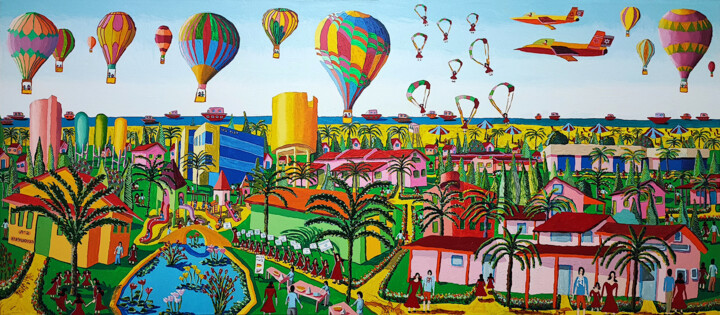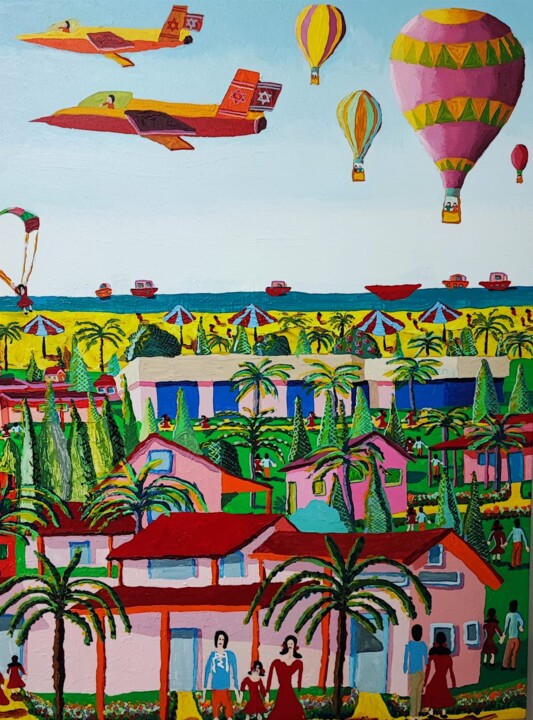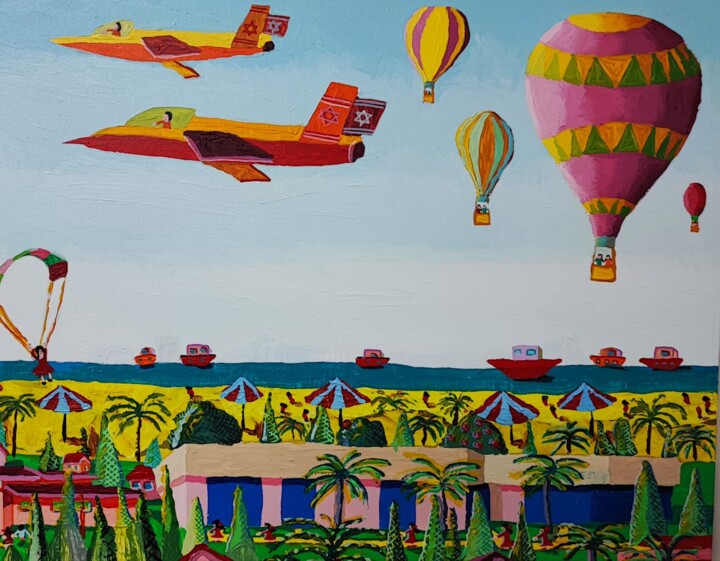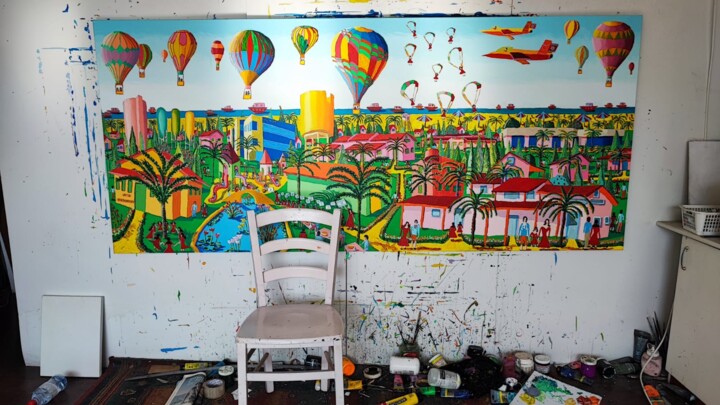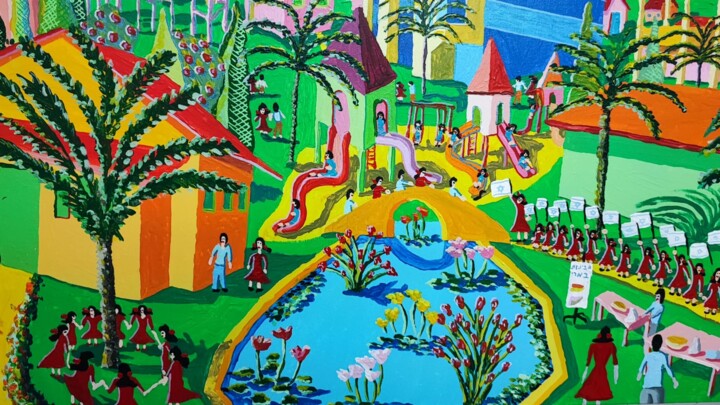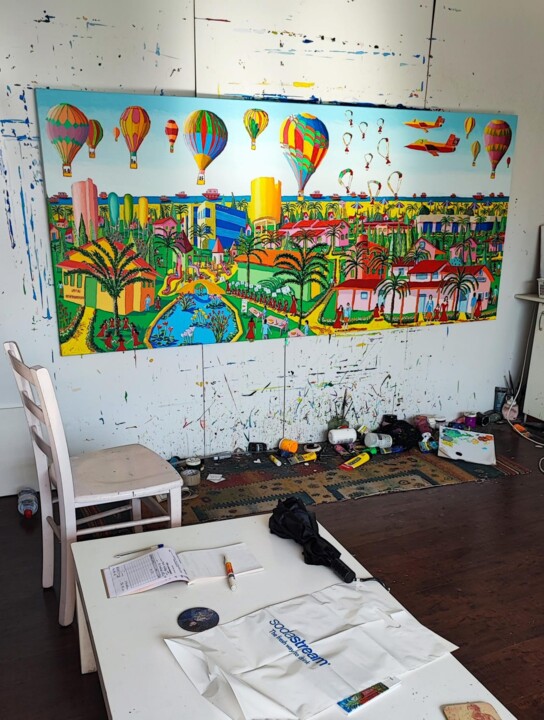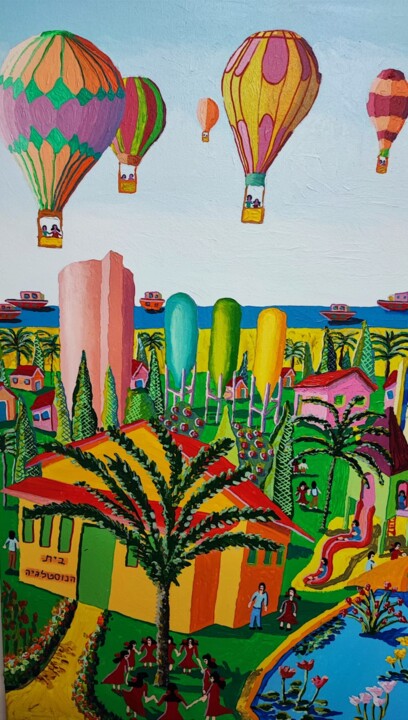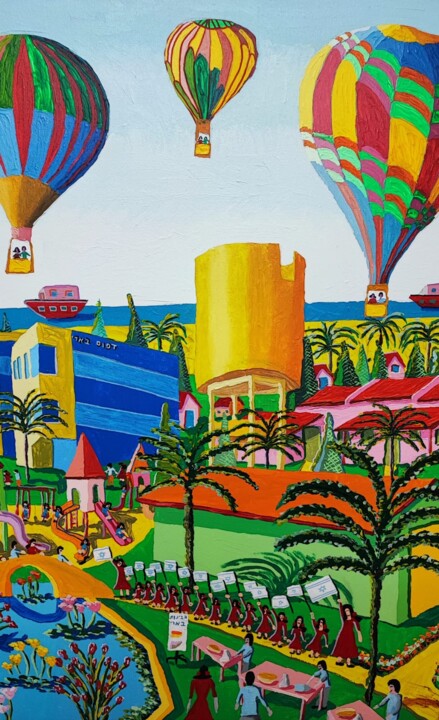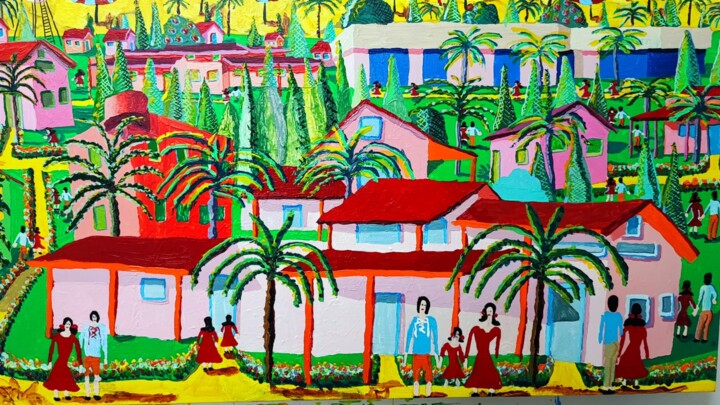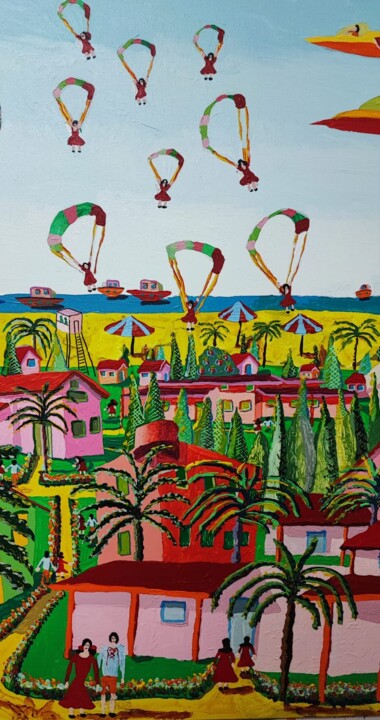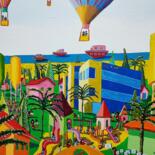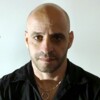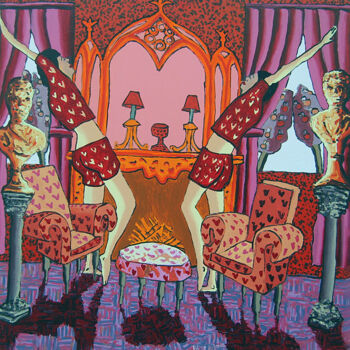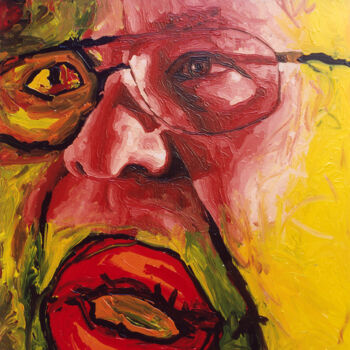naive art Kibbutz Be'eri The restoration after the massacre (2023) Painting by Raphael Perez
Sold by Raphael Perez
This image is available for download with a licence
Sold by Raphael Perez
-
Original Artwork (One Of A Kind)
Painting,
Acrylic
on Canvas
- Dimensions Height 43.3in, Width 98.4in
- Artwork's condition The artwork is in perfect condition
- Framing This artwork is not framed
- Categories Naive Art Landscape
As of June 26, 2022, the kibbutz population numbered approximately 1,108 people and is the largest settlement in terms of population in the Eshkol Regional Council.
the first years
Kibbutz Bari on the day of the ascension
The kibbutz came up on the ground in the Wadi Nakhabir area, on the mouth of the ancient Beer Sheva-Gaza canyon that was in the Miocene period, several kilometers south of Kibbutz Barot Yitzhak, from where the founders came. The founders of the kibbutz were from two cores - the training of the youth working and studying in Ma'oz Haim and the second core of Scouts. They were joined by a group of immigrants from Iraq who underwent training at the level of the conqueror. In the first years, only part of the core lived in the kibbutz itself and the rest of the group lived in the fence, for security and economic reasons. During the War of Independence, the kibbutz was bombed by the Egyptian army. A sign was erected near the kibbutz and the residents were armed with a limited number of rifles and mortars.
After the establishment of the state, the kibbutz was moved 3 kilometers to the southeast, to an area with more suitable areas for cultivation, where it is still today.
The kibbutz follows
The main source of livelihood for the kibbutz is a modern printing factory "Bari Printing", which is based on a printing press established in the early years of the kibbutz. There is also agriculture - Sde Pardes crops and a bicycle center for pedalling. The kibbutz is partially owned by A.B. Planners.
Being an agricultural settlement or a settlement in a development area, workers who move their place of residence to the settlement and live there for at least six consecutive months, benefit from the fact that if they quit their job for that purpose, the resignation will be considered as dismissal for them. Being one of the localities surrounding Gaza, its residents are given an income tax credit in accordance with Article 11 of the Income Tax Ordinance.
In 2006, a synagogue was inaugurated in the kibbutz, at the initiative of some of the residents.
In Bari, the superfood Mankai is grown, which is a cultivated variety (registered variety) of kelp.
Kibbutz Bari, 2022
The dining room and in front of it an art wall created by Moshe Saidi
security
During Operation Tzuk Eitan in the summer of 2014, a squad of nine terrorists infiltrated Israel through a tunnel, about 9 km from the kibbutz. The squad ambushed an IDF jeep, murdered Major Amots Greenberg and his driver Adar Bresno, and returned to Gaza. In the summer of 2015 , at a propaganda festival of the Hamas media department to mark the anniversary of the operation, several videos of the organization were distributed. One of the videos documented, according to Hamas, an intrusion into Kibbutz Bari. Haim Yelin, head of the Eshkol Regional Council at the time of the operation, said the video was fake: there was no infiltration of Bari and the visible area at all In the background of the video are not the hills of Bari, but dunes on the Gaza coast.
During the spring of 2018, between three and four incendiary kites were launched towards the area every day from the Gaza Strip, which caused fires in the area. Following the fires, a "fire patrol" was established in the kibbutz to deal with the many fires. Also, the kibbutz suffered from shelling during the rounds of fighting between the Gaza Strip and Israel.
In 2023, in a surprise attack on Israel, Hamas terrorists carried out a massacre in the settlements surrounding Gaza. Many of the residents of the kibbutz were murdered and kidnapped.
The cook in the kibbutz
Extended value - the massacre in Bari
On Saturday, October 7, 2023, the holiday of Simchat Torah, at the beginning of the surprise attack on Israel, more than a hundred well-armed terrorists infiltrated the kibbutz. They overcame the emergency squad and first responders who were called to the scene, and carried out a massacre of the kibbutz residents, in which more than 130 of the kibbutz residents were murdered. A number of residents were kidnapped in the Gaza Strip by Hamas. Additional forces, under the command of Brigadier General Barak Hiram, arrived at the kibbutz, and in heavy fighting, which lasted until Monday afternoon, the cleansing of the kibbutz from terrorists was completed, including those who had barricaded themselves in various compounds in the kibbutz, some with trapped civilians. As of November 2023, the place functions as a closed military area.
sites around the kibbutz
The water tower and security house of Kibbutz Bari
There are several tourist sites near the kibbutz. To the north of the kibbutz is a reserve in Tarot Bari, which is a center of attraction in the winter, during the anemone blooming season. The reserve contains the first settlement site of Bari ("Nahabir"), the Bari Sulfur Mines, an abandoned sulfur factory from the days of the British Mandate, the Anzac Hand, a monument to Anzac martyrs from World War I, and British ammunition storage buildings from World War II. There are also bicycle routes for families and experienced riders.
Barry Gallery operated in the kibbutz starting in October 1986, and presented exhibitions in which the best artists in Israel participated. In the massacre carried out by Hamas terrorists, the gallery was completely destroyed. The gallery will operate in Beit Romano in Tel Aviv.
In the Sinai War, the Six Day War and the Yom Kippur War, an emergency military cemetery was established at a site northeast of the kibbutz, where some of the victims of the Sinai battles were buried. After the three wars, the graves were moved from there to permanent burial and the cemetery was dismantled.
Related themes
Raphael perez Hebrew name rafi peretz was born into a traditional family and grew up in Jerusalem.
Family biography Raphael Perez father, Shimon Perez, worked as a receptionist at Hadassah Ein Kerem Hospital in Jerusalem. His great love was art, but as a breadwinner, he could not fulfill his dream of becoming an artist. Raphael’s mother, Alice Aliza Perez, worked as an assistant to a kindergarten teacher and later took care of a baby at home. She loved gardening and nature, and together with her husband, created a magnificent garden.
Raphael has several siblings. His elder brother David Perez repented in his mid-twenties and brought many people back to repentance. His sister Hana Peretz raised eight children and worked in the field of education. His brother Avi (Abraham) Peretz studied Philosophy and Judaism in Israel before moving to the United States where he completed his master’s degree in education and became a conservative rabbi. His fourth brother is Asher Peretz, who is very fond of traveling and has been to magical places all over the world. Raphael is the fifth sibling and has a twin brother named Miki (Michael) Peretz, who is a talented industrial designer. The youngest sibling is Shlomit Peretz, who has been involved in the Bezeq telephone company for almost three decades.
Peretz). In the IDF, he served in the Artillery Corps. He worked for 15 years in education in therapeutic settings for children and taught art and movement.
Peretz is a graduate of the Center for Visual Arts in Be'er Sheva, where he studied from 1989-1992. He has been painting since 1989 and since 1999 earns a living only from selling art. Since 1995 he has lived and worked from his studio in Tel Aviv.
Between the ages of 17 and 32, he wrote about forty diaries, sketchbooks and artist books in which he wrote daily and described his thoughts, experiences and feelings and his struggle with his homosexual sexual orientations. He later adorned the diaries with illustrations and drawings. The diaries were presented in a solo exhibition at Camera Obscura and in a group exhibition at the Sommer Gallery.
In his work, starting in 1995, he dealt with relationships, initially with relationships between men and women, in which complex relationships between men and women can be seen. In addition to explicit paintings, he created series of flower paintings, as a metaphor for the relationship between a man and a woman.
At the age of 32 he came out of the closet and began to draw relationships between men. At first, the paintings express hesitation and imperfection, while Peretz does not reveal the faces of the cartoonists. After his first love for a man in 1999 and coming to terms with his sexual orientation, the paintings became peaceful and he presented the homosexual relationship in an ideal way. Peretz has created a series of naive paintings that deal with loving relationships between men and common daily activities in the home environment. Over the years he painted his mates.
-
Nationality:
ISRAEL

- Date of birth : 1965
- Artistic domains:
- Groups: Contemporary Israeli Artists

